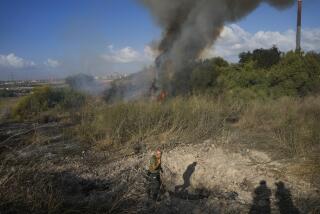Airlines Called Vulnerable to Attack by Terrorist Missiles
- Share via
WASHINGTON — The attack this week on an Israeli charter plane in Kenya underscores the vulnerability of commercial jets to terrorists wielding shoulder-fired missiles, which are relatively cheap, portable and widely available on the international black market, U.S. and Israeli officials and private analysts said.
Israeli officials on Friday said the Arkia Charter Co. jet carrying 271 people that was fired on twice by surface-to-air missiles Thursday apparently was spared by bad aim from an old, inaccurate weapon. But civilian aircraft owned by Israel’s flagship carrier, El Al, are equipped with flares that act as decoys for the heat-seeking weapons.
“This is not only an Israeli problem,” Avi Pazner, an Israeli government spokesman, told Associated Press. “What can be done against an Israeli aircraft can easily be done against a European or American one.”
“This is going to cause an enormous shudder throughout the [U.S.] government,” said Daniel Benjamin, a former National Security Council counterterrorism expert at the Center for Strategic and International Studies, or CSIS, in Washington.
Security analysts have been warning for years about the potential threat posed by terrorists toting shoulder-fired missiles. Al Qaeda is believed to have fired them at planes in Saudi Arabia and Yemen, and the Tamil Tiger rebels used them to down a passenger aircraft in Sri Lanka in 1998.
In the United States, Benjamin said, “the airlines have always refused to consider putting aboard the defense measures that are necessary, for reasons of cost.... Even though the airlines are in worse [financial] shape now, it’s hard for me to see how they’re going to avoid a big, big battle over this.”
However, another CSIS terrorism expert, Anthony Cordesman, a former director of intelligence assessment at the Pentagon, said installing systems on commercial airlines to defend against attack by shoulder-fired missiles is not likely to be either feasible or effective.
A spokesman for Boeing Commercial Airlines, Craig Martin, agreed that putting missile-defense technology aboard commercial aircraft would be neither cheap nor easy.
And he argued that the basic premise of the air travel industry -- the free and safe flow of civilian air traffic -- would be undermined by a decision to try to defend aircraft against missiles.
“You won’t put your family on an aircraft if you think it’s going to be hit by a missile, regardless of what defenses are on board,” Martin said. He suggested that authorities focus on the underlying causes of the attacks and on making such attacks unacceptable.
Meanwhile, a U.S. General Accounting Office report released two days before the Kenya attack warns that the systems developed by the Pentagon to protect military aircraft from surface-to-air missiles also are unreliable.
The GAO, Congress’ watchdog agency, had already warned in a January 2001 report about problems with the military’s capability to suppress enemy air defenses.
“The services have already identified serious reliability problems with current self-protection systems on U.S. combat aircraft, including jammers, radar warning receivers and countermeasures dispensers,” the GAO wrote in the report released this week. “Most of the current systems use older technology and have logistics support problems due to obsolescence.”
The report said that 41 of 44 F-15C aircraft and 10 of 10 F/A-18C aircraft reported to be mission-capable were subsequently found to have two or more faults in their self-protection systems. One F/A-18C had 12 such faults.
The report also found significant problems with aircraft designed to jam the radars of air defenses, and with other craft that fire anti-radiation missiles to destroy air defenses.
“Over the past several years, the quantity and quality of the services’ suppression equipment have declined while enemy air defense tactics and equipment have improved,” the GAO said.
The missiles fired at the Israeli plane are believed to have been the Soviet-made SA-7, also known by the Russian name Strela-2M. They are older and less accurate versions of the U.S.-made Stinger missiles, which the CIA supplied to the moujahedeen warriors fighting the Soviets in Afghanistan in the 1980s.
The SA-7s were introduced in 1967 and first used by Soviet-backed Egyptian forces against Israel.
When U.S. relations with Egypt later improved, some of the missiles were sent to Germany, where U.S. troops trained with them.
“There are just thousands all over the world,” said retired Army Maj. Gen. Edward B. Atkeson, a senior fellow at the Institute of Land Warfare. “Everybody’s got them. They’re cheap, and it takes only about a day to train a guy on the thing.”
The SA-7s are heat-seeking weapons that lock onto a jet’s exhaust.
Defense systems on U.S. fighter planes use sensors to detect the missile’s heat, then activate flares designed to confuse the missile’s guidance system by sending out waves of heat over a wide area.
But because passenger airplanes ascend and descend slowly, sending out heat from their engines all the while, they are vulnerable to targeting by such missiles for far longer than speeding jet fighters, Cordesman said. This makes it relatively impractical to use heat-based defenses on commercial craft.
Companies are exploring other technologies -- a Russian firm claims to have a “missile death ray,” essentially a laser beam that blows up a missile before it reaches the aircraft -- but U.S. sources said the products are unproven and may be too large for anything but military applications.
Most shoulder-fired missiles believed to have fallen into the hands of terrorists are versions of the Strela and are old enough to be highly unreliable, Cordesman said.
Systems that protect against them are not effective against more modern missile guidance systems that, instead of locking onto a craft’s exhaust heat, home in on its radar profile or flight trajectory.
“Everything in technology is a duel,” Cordesman said. “Do you put these defense systems on airliners to deal with Strelas? If so, will it work against the newer missiles? Can terrorists get the newer missiles? The answer to that, like everything else about terrorism, is uncertain.”
Another uncertainty is how many of the more modern and accurate Stinger missiles may have fallen into terrorist hands. According to a comprehensive 1999 study by Alan J. Kuperman, now at the School for Advanced International Studies in Bologna, Italy, some of the estimated 900 to 1,200 Stingers delivered to Afghanistan in the 1980s were skimmed off en route through Pakistan, with some reportedly ending up on the black market. Others reportedly were hoarded or sold to Iran.
The CIA reportedly has spent $65 million on three buy-back programs to get the remaining missiles out of Afghanistan and off the black market.
An agency spokesman Friday would not comment. But Kuperman reported that one main effect of the program has been to drive up the black market price for Stingers, from about $30,000 to as much as $200,000 each.
*
Times staff writer Warren Vieth contributed to this report.
More to Read
Sign up for Essential California
The most important California stories and recommendations in your inbox every morning.
You may occasionally receive promotional content from the Los Angeles Times.










